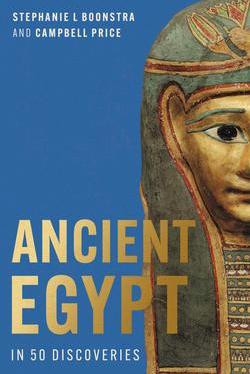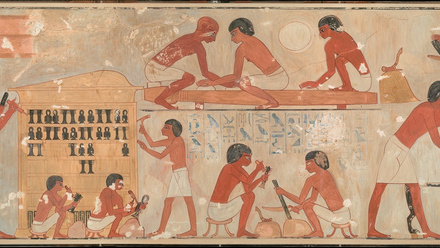Explore Ancient Egypt in 50 (EES) Discoveries

Thanks to the generous support of our members in 2023, we’re proud to present our latest book, Ancient Egypt in 50 Discoveries: Highlights from the first century of the Egypt Exploration Society edited by Stephanie L Boonstra and Campbell Price.
For the first time (in print), we explore the entirety of ancient Egyptian history through the lens of the Society’s work since 1882. Readers will journey through time and space from Predynastic Abydos through to the papyri-filled rubbish mounds of Graeco-Roman Oxyrhynchus as they uncover little-known artefacts and places that have played an important role in our understanding of ancient Egyptian history.
Entries in the book have been written by experts working in collections and projects around the world, notably by Egyptian scholars who participated in the Society’s 2022 Egyptological Archives Skills School.
This book represents an essential guide to the history of ancient Egypt providing valuable context to archaeological discoveries, unpacking challenging topics, and introducing some of the lesser-known characters who have contributed to the Society’s work.
This is a book that anyone interested in the history of Egypt shouldn’t be caught without!
A limited number of GOLD titled copies are available. Get your copy before they run out.
Inside this book
Praise for this book
A compendium of superb scholarship and discovery. Ancient Egypt in 50 Discoveries is a wonderful box of delights of scholarship and discoveries. This is a brilliant book and Ancient Egypt bursts from its pages in all its variety and complexity. Fascinating and unmissable.
I wish I’d written this book!
Drawing on the objects, but also the archival material that shows how they were discovered, Ancient Egypt in 50 Discoveries tells the story both of ancient Egypt and of a very important part of the history of Egyptology.
How do we know what we know about the ancient past in Egypt? This is the book to answer that question.
This lavishly illustrated book is a delightful romp through more than 3000 years of ancient Egyptian history that also provides a glimpse of the history of Egyptology and current trends in public engagement. It demonstrates the rich variety of the components of ancient Egyptian culture, encompassing statues, socks, mummified ibises, coffins, papyri, pots, and much much more, which whet the appetite for further exploration of ancient Egypt.
This small book reflects the huge impact the Egypt Exploration Society has made at both a local and international level. By showcasing artefacts in collections far beyond the usual museums, these are further enhanced by the society’s rich archive of photographs, from the face of the builder of the Great Pyramid to everyday lives in the city of Nefertiti and Tutankhamun. And the book certainly lives up to its subtitle ‘Highlights from the first century of the Egypt Exploration Society’, its content and accessible format further evidence that this very special organisation remains at the forefront of Egyptology well into the 21st century too.
A fascinating exploration of how our understanding of ancient Egypt is fundamentally grounded in its material culture as revealed by archaeology – and how much of that archaeology stands to the credit of the Egypt Exploration Society.
Ancient Egypt in 50 Discoveries takes the reader on a stroll though the past pausing to examine the stuff that ancient lives were made of, unusual artefacts unearthed during the 19th century excavations of the Egypt Exploration Society. Like the best strolls, this one is leisurely and the companions memorable, authors of succinct, informed commentaries situating an exceptional collection, whose assembly has itself become an Egyptological artefact, in the updated histories of Egypt and its study.
This book represents a valuable overview of key discoveries from ancient Egypt in the history of the Egypt Exploration Society. But it provides more than a list of artefacts; it situates and contextualises them within a broader framework and also engages with the colonial attitudes and socio-political structures that led to their removal from Egypt.



